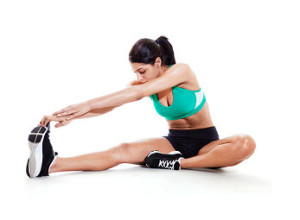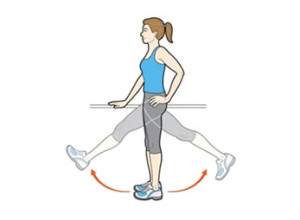There has been an ongoing debate over the last decade as to what is the best type of stretching for sports performance and injury prevention: dynamic or static stretching?
A definition of both dynamic and static stretching is required to answer this question:
[one_half] Static stretching is used to stretch muscles while the body is at rest. It is composed of various techniques that generally lengthen a muscle to an elongated position (to the point of discomfort), which are held for a period of 15 seconds to 2 minutes. For example, a static hamstring stretch as seen below:
 [/one_half] [one_half_last] Dynamic stretching on the other hand uses movement or momentum of the limb or trunk to move the muscle between its extremes of range. It is a controlled movement and should not be vigorous or bouncy at the end of range. For example, a dynamic hamstring leg swing as seen below:
[/one_half] [one_half_last] Dynamic stretching on the other hand uses movement or momentum of the limb or trunk to move the muscle between its extremes of range. It is a controlled movement and should not be vigorous or bouncy at the end of range. For example, a dynamic hamstring leg swing as seen below:
 [/one_half_last]
[/one_half_last]
Sports Performance
A recent review of the current research pertaining to pre-exercise static stretching by Simic et al (2013) found that static stretching prior to exercise can actually reduce muscle strength, power and explosive performance. The review included 104 studies on static stretching and concluded that “the usage of static stretching as the sole activity during the warm-up routine should generally be avoided”.
A closer look at this review, however, found the detriments in performance (although statistically significant) to be quite small (between 1.9-5.0%). It is also worth noting that these negative effects are in fact negligible if the stretch was held for less than 45 seconds (which most stretches are) and the negative effects were only short lived, with performance returning back to normal within 5-10 minutes after stretching. The review also further concludes that short static stretching is recommended for activities that involve slower eccentric contractions or sports that require greater ranges of movement. Some examples would include the ability of a goaltender in ice hockey to maximally abduct his/her legs when in a butterfly position, gymnasts performing and holding a split position, wrestling, martial arts, synchronized swimming, figure skating and others. Although some studies have indicated that dynamic stretching provides similar increases in static flexibility as static stretching (Beedle and Mann 2007), other studies have indicated that dynamic stretching is not as effective at increasing static flexibility as static stretching within a single warm-up session (Bandy et al. 1998; O’Sullivan et al. 2009) or with prolonged training (Covert et al. 2010). Hence, it could be important to include static stretching in the warm-up for specific sport flexibility applications.
In the context of dynamic stretching, the literature tends to indicate that greater than 90 seconds of dynamic stretching prior to exercise may significantly enhance performance (Bacurau et al. 2009; Beedle et al. 2008; Bradley et al. 2007; Christensen and Nordstrom 2008; Gelen 2010; Jaggers et al. 2008; Papadopoulos et al. 2005; Samuel et al. 2008; Sekir et al. 2009; Torres et al. 2008; Unick et al. 2005). 10 minutes of dynamic warm-up activities (stretching or aerobic activity) have been reported to result in improvements in shuttle run time, medicine ball throw distance and five step jump distance (McMillian et al. 2006). A study by Hough et al (2009) also demonstrated improvements in performance, with an increase in vertical jump height and quadriceps EMG activity after 7 minutes of dynamic stretching.
Injury Prevention
With respect to the effect of pre-participation static stretching on injury prevention, a limited number of studies of varying quality have shown mixed results for both dynamic or static stretching. A general consensus is that stretching in addition to warm-up does not affect the incidence of overuse injuries. There is limited evidence that pre-participation stretching reduces the incidence of muscle strains but there is clearly a need for further work (McHugh et al 2010). Future studies should use stretching interventions that are effective at decreasing passive resistance to stretch and assess effects on subsequent injury incidence in sports with a high prevalence of muscle strains.
What is the take home message?
To achieve optimal sports performance, the warm-up should be composed of a submaximal intensity aerobic activity followed by large amplitude dynamic stretching and then completed with sport specific dynamic activities. As static stretching can still increase range of motion, it still plays an important role for health-related benefits associated with flexibility and particular sports or activities that necessitate a great increase in static ROM relative to the flexibility of the athlete or patient. However, static stretching should normally not be pursued prior to strength, high speed, explosive or reactive activities, except during sports that require greater ranges of movement (static stretches should be held for no longer than a total of 30 seconds per muscle group). All individuals should include static stretching in their overall fitness and wellness activities for the health and functional benefits associated with increased range of motion and musculotendinous compliance. However, a separate static stretch training workout time or during post-exercise cool-down should be planned independent of other training workouts or competitions to achieve a more permanent change in flexibility for health or performance.
References:
Bacurau RF, Monteiro GA, Ugrinowitsch C, Tricoli V, Cabral LF, Aoki MS (2009) Acute effect of a ballistic and a static stretching exercise bout on flexibility and maximal strength. J Strength Cond Res 23:304–308
Bandy WD, Irion JM, Briggler M (1998) The effect of static stretch and dynamic range of motion training on the flexibility of the hamstring muscles. J Orthop Sports Phys Ther 27:295–300
Beedle BB, Mann CL (2007) A comparison of two warm-ups on joint range of motion. J Strength Cond Res 21:776–779
Behm DG, Chaouachi A. A review of the acute effects of static and dynamic stretching on performance. Eur J Appl Physiol 2011: 111: 2633–2651.
Behm DG, Bambury A, Cahill F, Power K. Effect of acute static stretching on force, balance, reaction time, and movement time. Med Sci Sports Exerc 2004: 36: 1397–1402.
Christensen BK, Nordstrom BJ (2008) The effects of proprioceptive neuromuscular facilitation and dynamic stretching techniques on vertical jump performance. J Strength Cond Res 22:1826–1831
Covert CA, Alexander MP, Petronis JJ, Davis DS (2010) Comparison of ballistic and static stretching on hamstring muscle length using an equal stretching dose. J Strength Cond Res 24(11): 3008–3014
Gelen E (2010) Acute effects of different warm-up methods on sprint, slalom dribbling, and penalty kick performance in soccer players. J Strength Cond Res 24:950–956
Jaggers JR, Swank AM, Frost KL, Lee CD (2008) The acute effects of dynamic and ballistic stretching on vertical jump height, force, and power. J Strength Cond Res 22:1844–1849
McHugh MP, Cosgrave CH. To stretch or not to stretch: the role of stretching in injury prevention and performance. Scand J Med Sci Sports 2010: 20: 169–181.
O’Sullivan K, Murray E, Sainsbury D (2009) The effect of warm-up, static stretching and dynamic stretching on hamstring flexibility in previously injured subjects. BMC Musculoskelet Disord 10:37–42
Papadopoulos G, Siatras T, Kellis S (2005) The effect of static and dynamic stretching exercises on the maximal isokinetic strength of the knee extensors and flexors. Isokinetics Exerc Sci 13:285–291
McMillian DJ, Moore JH, Hatler BS, Taylor DC (2006) Dynamic vs. static-stretching warm up: the effect on power and agility performance. J Strength Cond Res 20:492–499
Samuel MN, Holcomb WR, Guadagnoli MA, Rubley MD, Wallmann H (2008) Acute effects of static and ballistic stretching on measures of strength and power. J Strength Cond Res 22:1422–1428
Sekir U, Arabaci R, Akova B, Kadagan SM (2009) Acute effects of static and dynamic stretching on leg flexor and extensor isokinetic strength in elite women athletes. Scand J Med Sci Sports
Simic L., Sarabon N., Markovic G. Does pre-exercise static stretching inhibit maximal muscular performance? A meta-analytical review Scand J Med Sci Sports 2013: 23: 131–148
Torres EM, Kraemer WJ, Vingren JL, Volek JS, Hatfield DL, Spiering BA, Ho JY, Fragala MS, Thomas GA, Anderson JM, Hakkinen K, Maresh CM (2008) Effects of stretching on upper body muscular performance. J Strength Cond Res 22:1279–1285
Unick J, Kieffer HS, Cheesman W, Feeney A (2005) The acute effects of static and ballistic stretching on vertical jump performance in trained women. J Strength Cond Res 19:206–212

